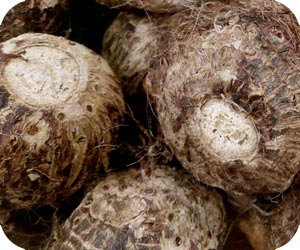Welcome to LastMorsel.com!
We have recipes, cooking tips, and more!
We have recipes, cooking tips, and more!
 Taro is the root of the taro plant, which is grown in semi-tropical and tropical climates all over the world.
Taro root is inedible raw and must be cooked thoroughly to leach out the calcium oxalate (associated with gout and kidney stones),
preferably with a pinch of baking soda.
Taro is the root of the taro plant, which is grown in semi-tropical and tropical climates all over the world.
Taro root is inedible raw and must be cooked thoroughly to leach out the calcium oxalate (associated with gout and kidney stones),
preferably with a pinch of baking soda.
Rich in Fiber: Taro is a great source of dietary fiber, which aids in digestion and helps maintain healthy bowel movements.
High in Vitamins and Minerals: Taro contains essential vitamins and minerals such as vitamin C, vitamin B6, vitamin E, manganese, potassium, and magnesium.
Low in Fat: Taro is low in fat, making it a healthy option for those looking to manage their weight.
Improved Digestion: The high fiber content in taro helps improve digestive health and can relieve issues like constipation and diarrhea.
Blood Sugar Management: Taro contains resistant starch, which helps stabilize blood sugar levels and is beneficial for people with diabetes.
Heart Health: The fiber and potassium in taro contribute to heart health by reducing cholesterol levels and controlling blood pressure.
Antioxidant Properties: Taro contains antioxidants like quercetin, which help protect the body from free radicals and reduce the risk of chronic diseases.
Supports Blood Health: Taro is rich in iron and copper, which are important for blood health and can help prevent anemia.
Taro can be used in a variety of dishes, from savory to sweet. It can be boiled, steamed, baked, or fried, and is often used in soups, stews, and desserts.
Taro containscalcium oxalate, which can cause health issues if not prepared properly. Here are some important points to consider:
Proper Cooking: Taro must be cooked thoroughly by boiling for the recommended amount of time to leach out the calcium oxalate, which is associated with gout and kidney stones. Undercooked taro can cause irritation in the mouth and throat.
Soaking: Soaking taro in water overnight before cooking can further reduce the amount of oxalates.
Combining with Calcium-Rich Foods: Eating taro with calcium-rich foods, such as milk, can help block oxalate absorption and reduce the risk of kidney stones.
Avoiding Raw Consumption: Taro should never be eaten raw, as it can cause numbness and irritation in the mouth and throat.